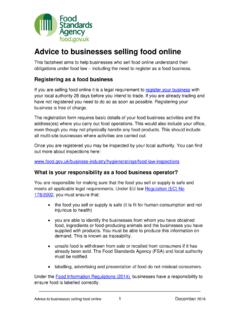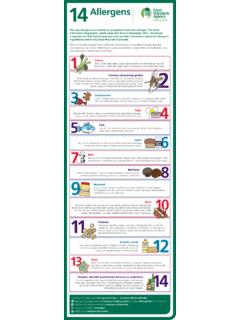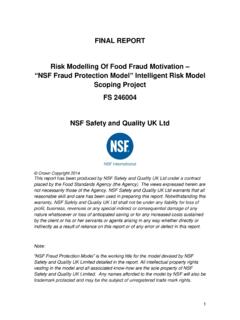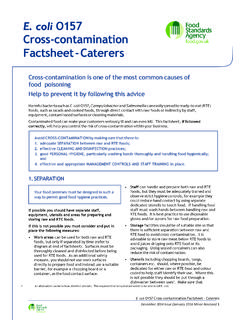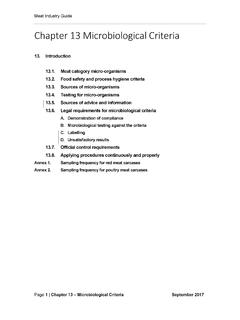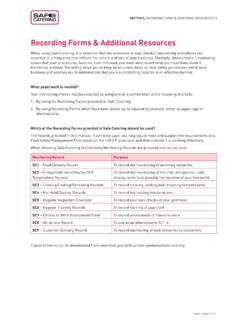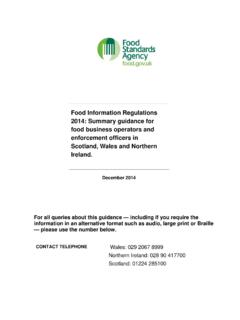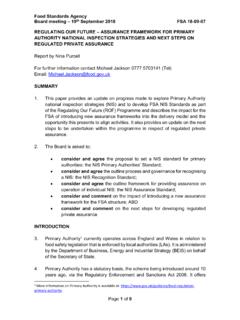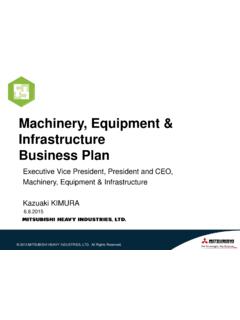Transcription of SAFE METHOD: READY-TO-EAT FOOD
1 food Standards Agency l METHOD: READY-TO-EAT food It is important to handle READY-TO-EAT food safely to protect it from harmful bacteria and food is food that will not be cooked or reheated before serving. This includes salads, cooked meats, smoked fish, desserts, sandwiches, cheese and food that you have cooked in advance to serve POINTWHY?HOW DO YOU DO THIS?When preparing and handling food , you should: keep READY-TO-EAT food completely separate from raw meat, poultry, fish, eggs and unwashed vegetables make sure work surfaces, chopping boards, knives etc. are clean (and disinfected if you have prepared raw food ) Ideally, use separate chopping boards and utensils for READY-TO-EAT food keep READY-TO-EAT food covered at all times during preparation and protects food from harmful bacteria and allergens.
2 This is especially important for READY-TO-EAT food because it will not be cooked or reheated before also helps keep allergens from spreading. List the types of READY-TO-EAT food you use and how you handle them:Follow the manufacturer s instructions on how to store and prepare the food , if these are manufacturer s instructions are designed to keep the food you confident that you do this for all READY-TO-EAT food where instructions are available? Yes When preparing fruit, vegetables and salad ingredients: peel, trim, or remove the outer parts, as appropriate wash them thoroughly by rubbing vigorously in a bowl of clean water wash the cleanest ones firstWash your hands before and after handling fruit and you have prepared vegetables that have dirt or soil on the outside, clean and then disinfect chopping boards and work surfaces before preparing other dirt on vegetables and salad ingredients can contain harmful bacteria.
3 Peeling and washing helps to remove the dirt and you do this? Yes If not, what do you do? food Standards Agency l POINTWHY?HOW DO YOU DO THIS?Make sure you keep READY-TO-EAT food cold enough. See Chilled storage and displaying chilled food in the Chilling not use READY-TO-EAT food after the use by date, if there is food you have prepared, or removed from its original packaging, you should have a method of keeping track of when food should be used or thrown these types of food are not kept cold enough, harmful bacteria could should never use food that has passed its use by date because it might not be safe to you do this?
4 Yes If not, what do you do?If you slice cooked meat: make sure you follow the manufacturer s instructions when you clean the slicer avoid handling the meat as much as possible it is a good idea to use clean tongs or slice meat straight onto a plateMeat slicers need careful cleaning and disinfecting to prevent dirt building up and to stop harmful bacteria growing, in particular on the slicing can easily spread harmful bacteria onto staff trained how to clean the meat slicer properly, or supervised?Yes No WHAT TO DO IF THINGS GO WRONGHOW TO STOP THIS HAPPENING AGAIN If you think that a food delivery has not been handled safely, reject the delivery.
5 If READY-TO-EAT vegetables, fruit or salad ingredients have not been washed properly, wash them following the advice on the first side of this Safe method and clean any work surfaces etc. they have touched. If READY-TO-EAT food has been prepared on a work surface or with a knife that has been used for raw meat, poultry, fish, eggs or unwashed fruit and vegetables, throw the food away. If READY-TO-EAT food has not been chilled safely, throw the food away. If you do not think a supplier handles food safely, consider changing to a new supplier. Review the way you receive deliveries. Review the way you store and prepare READY-TO-EAT food .
6 Train staff again on this safe method. Improve staff TWICE!You should not use the same equipment, such as vacuum packing machines, slicers and mincers, for both raw and ready-to eat food . These are complex pieces of machinery with lots of moving parts and it is very difficult to clean them sufficiently, so bacteria from raw food could easily be transferred to READY-TO-EAT you are preparing both raw and READY-TO-EAT food , you should make sure where possible this is done in separate clean and disinfected areas. If this is not possible, surface and utensils used must be thoroughly cleaned and then disinfected between sure staff wash their hands thoroughly between tasks, especially when working with raw and READY-TO-EAT food .
7 This stops bacteria and allergens being spread onto foods, surfaces and down what went wrong and what you did about it in your diary.
